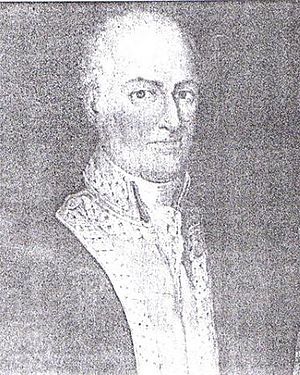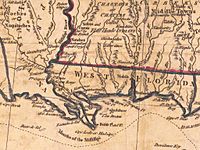Arturo O'Neill facts for kids
Quick facts for kids
Arturo O'Neill
|
|
|---|---|
 |
|
| 1st Spanish Governor of West Florida | |
| In office May 9, 1781 – November 1792/1794 |
|
| Preceded by | Peter Chester (British West Florida (1770–1781)) |
| Succeeded by | Carlos Howard |
| 93rd Colonial Governor of Yucatán | |
| In office December 13, 1792 – October 19, 1800 |
|
| Lieutenant | Benito Pérez Valdelomar |
| Preceded by | Jose Sabido de Vargas |
| Personal details | |
| Born |
Arthur O'Neill
January 8, 1736 Dublin, Ireland |
| Died | December 9, 1814 (aged 78) Madrid |
| Profession | Military and political career |
Arturo O'Neill de Tyrone y O'Kelly (born January 8, 1736 – died December 9, 1814) was an important Spanish leader. He was born in Ireland but served the Spanish government. He became a colonel and later a governor in different parts of New Spain, which was a large area controlled by Spain in the Americas. His family had been important in Europe for a very long time.
Contents
Arturo O'Neill's Life Story
Early Life and Becoming a Soldier
Arturo O'Neill was born in Dublin, Ireland, on January 8, 1736. His family originally came from County Tyrone. He was one of five children. His parents, Henry O’Neill and Ana O’Kelly, had to leave Ireland. This was because their family lost their lands there. So, they moved to Spain.
In 1752, when Arturo was 16, he joined the Irish regiment in Spain. He started as a cadet, which is like a trainee officer. The next year, he moved to the Regiment of Hibernia. He stayed with this group for 28 years. During this time, he moved up in rank. He became a sub-lieutenant, then a lieutenant general, and a field marshal.
Arturo O'Neill fought in several wars. In 1762, he was part of a campaign in Portugal. Later, he served in Oran, Algeria. In 1775, he fought in a military campaign in Algiers. He also helped in a fight against Brazil. During this time, he helped capture Fort Santa Cruz on Santa Catalina Island. He even served as governor there for a short time.
His skills as a soldier were noticed. In 1764, he became an Assistant Major. By 1773, he was a captain. He showed great bravery in 1781 during the Siege of Pensacola. This was a battle against the British. Because of his excellent service, he was promoted to colonel.
Governor of West Florida

After the Battle of Pensacola ended on May 9, 1781, Arturo O'Neill got a new job. He was made the governor of Spanish West Florida. This area was part of New Spain. He was a very good leader and a skilled diplomat. He knew how to work with different groups of people. Later, he became an important advisor on military matters.
In 1784, Governor O'Neill took part in a meeting with the Creek Native Americans. Spain and the Creeks signed a friendship treaty. The Creeks, Chickasaws, and Cherokees also asked O'Neill for help. They wanted protection from American settlers moving into their lands. So, O'Neill sent soldiers to help them. In 1786, another treaty was made with Native Americans in Mobile. This helped keep peace and protect Spanish lands.
By 1787, O'Neill had been governor for six years. He asked the Spanish king for a new job. He wanted to be promoted to brigadier and become governor of Puerto Rico. But his request was not granted.
In 1788, O'Neill became ill. He asked for time off to get better. The king agreed, and Francisco Cruzat took over as governor for a while. In 1789, O'Neill was promoted to brigadier general.
When O'Neill returned to Pensacola in 1790, he worked to make the area stronger. He created a new group of soldiers called the Third Battalion. In 1792, he received a special title: Marqués del Norte (Marquess of the North).
To protect Florida, he suggested creating six companies of soldiers. These companies would be made up of 100 Native American and mestizos (people of mixed Spanish and Native American heritage) soldiers. O'Neill believed that people of mixed heritage had better relationships with the Spanish. He wanted to encourage Spanish soldiers to marry Native Americans. He thought this would make the region stronger both militarily and economically.
Arturo O'Neill left his job as Governor of West Florida in November 1792. Carlos Howard took his place.
Governor of Yucatán and Later Years
On December 13, 1792, Arturo O'Neill became the governor and captain general of Yucatán. He also became the Intendent of Tabasco and Laguna de Términos. His role as governor was expanded in 1793. During his time in Yucatán, he quickly worked to stop the spread of rabies. This was a serious health problem for the people. He also made sure there were more teachers for schools. He had to deal with smuggling, which was illegal trade happening from Cuba and other Caribbean islands.
O'Neill ordered the capture of a ship called La Bella Jane in San Francisco de Campeche. In 1795, he wrote a book about Yucatán, but it was never printed. In 1798, he led an attack on British settlements in Belize. This was called the Battle of St. George's Caye. His Spanish forces tried to take over the settlements, but they were not successful. After two hours of fighting, the Spanish retreated. No one was hurt on either side.
He served as governor of Yucatán until October 19, 1800. After this, he returned to Madrid, Spain. There, he became a Minister in the Royal and Supreme Council of War. His last job was as a soldier in the Spanish army. He fought against France during the Napoleonic Wars. In 1802, he was promoted to lieutenant general.
Arturo O'Neill died in Madrid on December 9, 1814. He was buried in a special place in a cemetery. He never married and did not have any children.
See Also
 In Spanish: Arturo O'Neill para niños
In Spanish: Arturo O'Neill para niños

